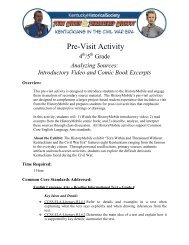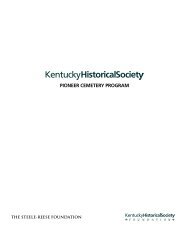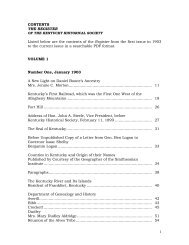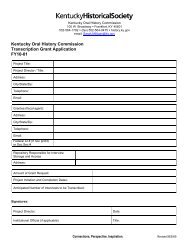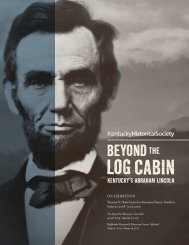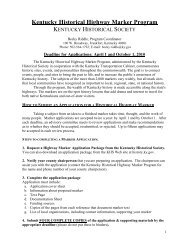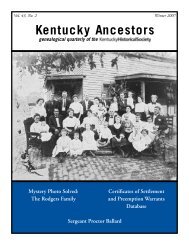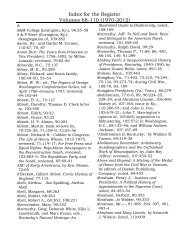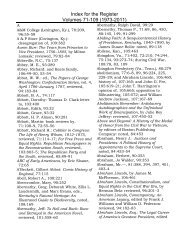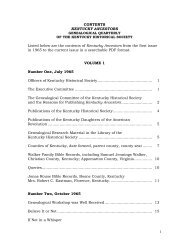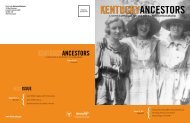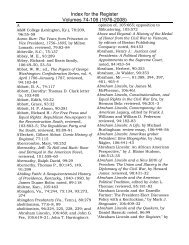Kentucky Ancestors, Volume 46, Number 3 - Kentucky Historical ...
Kentucky Ancestors, Volume 46, Number 3 - Kentucky Historical ...
Kentucky Ancestors, Volume 46, Number 3 - Kentucky Historical ...
You also want an ePaper? Increase the reach of your titles
YUMPU automatically turns print PDFs into web optimized ePapers that Google loves.
<strong>Kentucky</strong> militia activity flourished in 1793–94<br />
during the final stages of the Northwest Indian War.<br />
Governor Isaac Shelby ordered the Sixth Regiment,<br />
<strong>Kentucky</strong> Militia into service between 22 April and<br />
24 June 1793, with most of the companies, including<br />
detachments under Sgt. David Allen and Ensigns<br />
Thomas Davis and David Fuhrman, assigned to the<br />
Lincoln County frontier. Two other detachments<br />
under Lt. Jonathan Logan and Ensign Christopher<br />
Clark saw duty near Russell Creek in Green County.<br />
Two mounted units replaced the Sixth Regiment<br />
on the frontier from 23 September to 14 November<br />
1793, including Lt. Col. John Adair’s Regiment of<br />
Cavalry—which mustered at Fort Washington (near<br />
present-day Cincinnati, Ohio) as part of the sublegion<br />
of <strong>Kentucky</strong> mounted cavalry under Maj.<br />
Gen. Charles Scott—and David Caldwell’s Battalion<br />
of Cavalry, <strong>Kentucky</strong> Volunteers. Lt. Col. Horatio<br />
Hall’s Regiment of Cavalry, containing a company led<br />
by Simon Kenton, the well-known frontiersman and<br />
colleague of Daniel Boone, also took the field during<br />
that time.<br />
In mid-1794, as Maj. Gen. Anthony Wayne<br />
and the Legion of the United States assembled<br />
for the final campaign against the Western Indian<br />
Confederacy led by Shawnee war chief Blue Jacket,<br />
a full brigade of <strong>Kentucky</strong> militia mustered into<br />
service. From 10-14 July, Gen. Scott fielded six<br />
battalions of mounted volunteers under Majors John<br />
Caldwell, Nathan Huston, Notley Conn, William<br />
Price, William Russell, and Aquila Whitaker. Joined<br />
by several companies of mounted spies and scouts<br />
under Captains Ephraim Kibbey, George Shrim,<br />
and William Wells, the Kentuckians marched with<br />
Wayne’s Legion to the climactic battle of Fallen<br />
Timbers near Maumee, Ohio, on 20 August 1794,<br />
where Price’s battalion served as the vanguard of the<br />
advancing American forces. 4 Following a decisive<br />
victory over Blue Jacket and his Native alliance, most<br />
of the <strong>Kentucky</strong> militia returned home and disbanded<br />
21-26 October 1794.<br />
Renewed threats of Indian hostilities in the<br />
early nineteenth century caused the recruitment<br />
of several militia units in 1806–1807. Companies<br />
under Captains Jesse Holmes, John Hughes, William<br />
Patterson, and Jonathan Taylor mustered from 25<br />
December 1806 to 24 January 1807. They were<br />
128 | <strong>Kentucky</strong> <strong>Ancestors</strong><br />
joined by Capt. James Elder’s Company of the<br />
Twenty-fourth Regiment, <strong>Kentucky</strong> Militia, from<br />
4 January to 2 February 1807. The main conflict,<br />
however, came with the outbreak of Tecumseh’s War,<br />
a Native uprising that culminated with the battle<br />
of Tippecanoe on 7 November 1811. In October<br />
1811, Capt. Frederick Geiger’s Company from<br />
Maj. Samuel Wells’ Corps of Mounted Riflemen,<br />
<strong>Kentucky</strong> Militia, joined the Fourth U.S. Infantry<br />
and assorted Indiana militia under the overall<br />
command of Governor William Henry Harrison for<br />
a preemptive strike against Shawnee chief, Tecumseh,<br />
at Prophetstown, located near the juncture of the<br />
Tippecanoe and Wabash rivers. After defeating<br />
several Native assaults during the early hours of 7<br />
November, Harrison’s forces burned Prophetstown<br />
and the <strong>Kentucky</strong> militia disbanded by 24 November<br />
1811.<br />
Compiled Service Records<br />
War Department records relating to the military<br />
service of volunteers in <strong>Kentucky</strong> militia companies<br />
during the late eighteenth and early nineteenth<br />
centuries are part of the holdings of the National<br />
Archives and Records Administration (NARA), and<br />
are located in Record Group (RG) 94, Records of the<br />
Adjutant General’s Office, 1780s–1917. Compiled<br />
military service records (CMSRs) offer the most<br />
immediate source of information. These records,<br />
created in the 1890s to improve the verification<br />
process for pension applications, were assembled<br />
by U.S. War Department clerks who abstracted<br />
service data for individual soldiers from various<br />
sources, including muster rolls, payrolls, morning<br />
reports, and other regimental records, onto a series<br />
of cards, creating a concise personal history. After<br />
completing carded records for Union veterans of the<br />
Civil War, the War Department in 1912 recreated<br />
service information for volunteers from earlier<br />
conflicts, including the Indian campaigns of the post-<br />
Revolutionary period (1784–1811).<br />
Within RG 94, the compiled service records<br />
for <strong>Kentucky</strong> militia are arranged in the series<br />
“Carded Records, Volunteer Organizations: Post-<br />
Revolutionary War Period, 1784–1811” (Entry 57),<br />
sorted alphabetically by state, and then by the name<br />
of the commanding officer or regimental designation.



